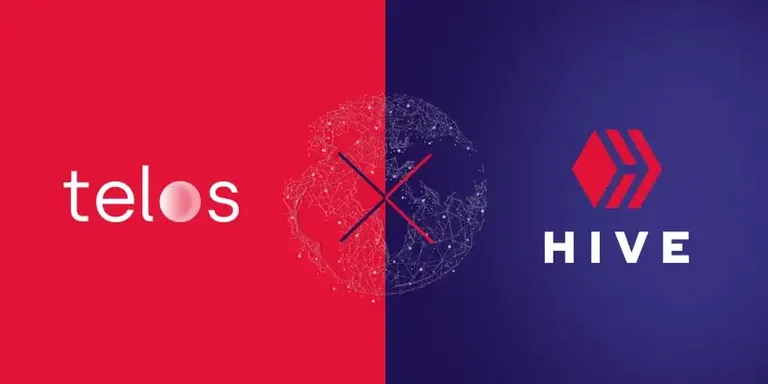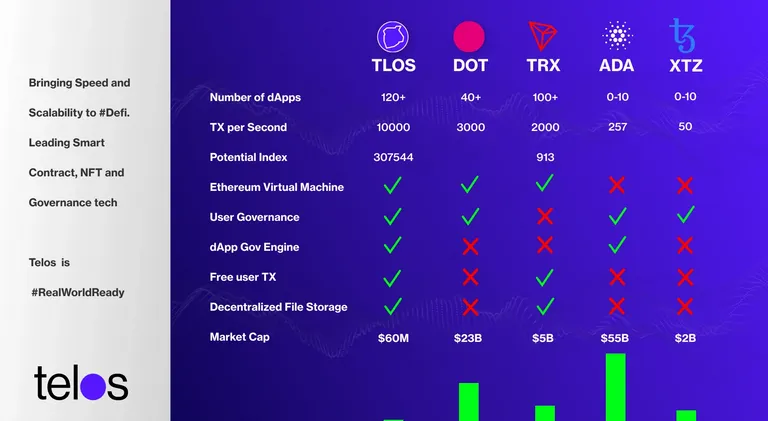
What is Telos (TLOS)?
Telos (TLOS) is a decentralized blockchain platform that aims to provide a high-performance, scalable, and secure infrastructure for decentralized applications and smart contracts. It has a number of features and capabilities that differentiate it from other cryptocurrencies, including:
High performance: Telos claims to have a faster transaction speed and lower fees than other blockchain platforms, making it suitable for applications that require fast and low-cost transactions.
Scalability: Telos uses a unique consensus algorithm called "Delegated Proof of Stake" (DPoS), which allows it to process a high number of transactions per second, making it more scalable than other blockchain platforms.
Decentralization: Telos has a decentralized governance structure, which means that decisions about the platform are made by a decentralized community of stakeholders rather than a central authority. This can increase the security and transparency of the platform.
Security: Telos has implemented a number of security measures, including a security reserve fund and a decentralized arbitration system, to ensure the integrity and stability of the platform.
What is HIVE?
HIVE (HIVE) is a decentralized blockchain, which provides a secure and transparent platform for the development and deployment of decentralized applications. The company's infrastructure is built on the Hive blockchain, which is a decentralized, open-source blockchain platform that is based on the technology of the Steem blockchain.
There are a number of features and capabilities that differentiate the Hive blockchain from other cryptocurrencies, including:
High performance: The Hive blockchain is designed to be a high-performance platform that can support a large number of transactions per second and has low fees, making it suitable for a wide range of decentralized applications.
Decentralized governance: The Hive blockchain has a decentralized governance structure, which means that decisions about the platform are made by a decentralized community of stakeholders rather than a central authority. This can increase the security and transparency of the platform.
Strong developer community: The Hive blockchain has a strong and active developer community, which is working on a number of projects and applications that are built on the platform. This can help drive innovation and adoption of the Hive blockchain.
Diversified revenue streams: HIVE is a public company that generates revenue through a number of sources, including the sale of cryptocurrency mining equipment and the operation of data centers. This diversification of revenue streams can provide a degree of stability and resilience to the company.
TLOS vs HIVE
HIVE (HIVE) is a decentralized blockchain, which is a decentralized, open-source blockchain platform that is based on the technology of the Steem blockchain.
On the other hand, Telos (TLOS) is a decentralized blockchain platform that is providing a high-performance, scalable, and secure infrastructure for decentralized applications and smart contracts. It is built on the EOSIO blockchain software and has a number of features and capabilities that differentiate it from other blockchain platforms, including a faster transaction speed and lower fees, as well as a decentralized governance structure.
There are a number of differences between the Hive and Telos blockchain platforms, including their underlying technology, governance structure, and target use cases. It's important to note that both of these platforms are highly speculative and carry a high level of risk due to their smaller market size and liquidity. Before making any investment decisions, it's essential to thoroughly research and carefully consider the risks and potential rewards.
Underlying technology:
The Hive blockchain is based on the technology of the Steem blockchain, which is a decentralized, open-source platform that uses a unique consensus algorithm called "Proof of Brain" to reward content creators and curators. The Hive blockchain was created as a fork of the Steem blockchain in order to address some of its perceived shortcomings, such as centralization and a lack of funding for development.
The Telos blockchain is built on the EOSIO blockchain software, which is a decentralized, open-source platform that uses a consensus algorithm called "Delegated Proof of Stake" (DPoS) to validate transactions and reach consensus. EOSIO is designed to be a high-performance platform that can support a large number of transactions per second and has a number of features that make it suitable for decentralized applications and smart contracts.
Governance structure:
The Hive blockchain has a decentralized governance structure, which means that decisions about the platform are made by a decentralized community of stakeholders rather than a central authority. This can increase the security and transparency of the platform.
The Telos blockchain also has a decentralized governance structure, which means that decisions about the platform are made by a decentralized community of stakeholders rather than a central authority. The Telos governance structure is based on a system of elected block producers, who are responsible for validating transactions and maintaining the security of the network.
Target use cases:
The Hive blockchain is primarily intended as a platform for decentralized applications and smart contracts that are focused on content creation and curation, such as social media platforms, blogging platforms, and online marketplaces.
The Telos blockchain is primarily intended as a general-purpose platform for decentralized applications and smart contracts, and it is designed to be flexible and scalable enough to support a wide range of use cases. Some potential use cases for the Telos blockchain include supply chain management, voting systems, identity verification, and prediction markets.
Telos EVM

Telos EVM (Ethereum Virtual Machine) is a feature of the Telos blockchain platform that allows it to support smart contracts and decentralized applications that are written in the Solidity programming language, which is commonly used on the Ethereum blockchain.
The Ethereum Virtual Machine (EVM) is a runtime environment that executes smart contracts on the Ethereum blockchain. It is designed to be a lightweight and efficient platform that can support a wide range of decentralized applications.
The Telos EVM is a fork of the Ethereum EVM that has been customized for the Telos blockchain platform. It allows developers to use the Solidity programming language and the Ethereum developer tools and libraries to build decentralized applications on the Telos blockchain.
It is an optional feature of the Telos blockchain, and it is not required to use the platform. However, it can be useful for developers who are familiar with the Ethereum ecosystem and want to build applications on the Telos blockchain using the Solidity programming language.
The Telos EVM (Ethereum Virtual Machine) is a fork of the Ethereum EVM that has been customized for the Telos blockchain platform. Some potential benefits of using the Telos EVM over other EVMs include:
Compatibility with Ethereum: The Telos EVM is compatible with the Ethereum EVM, which means that it can support smart contracts and decentralized applications that are written in the Solidity programming language and use the Ethereum developer tools and libraries. This can make it easier for developers who are familiar with the Ethereum ecosystem to build applications on the Telos blockchain.
High performance: The Telos blockchain is designed to be a high-performance platform that can support a large number of transactions per second and has low fees, which can make it suitable for a wide range of decentralized applications.
Decentralized governance: The Telos blockchain has a decentralized governance structure, which means that decisions about the platform are made by a decentralized community of stakeholders rather than a central authority. This can increase the security and transparency of the platform.
Conclusion
Now both of these blockchains have their benefits, and can work together to enhance Web3.
With Hive coming from Steem, and TLOS coming from EOS... You could say that since Dan Larimer created both of those that we are very similar and part of the same family in some ways!
I have been a part of both communities for years, and both are very welcoming and have exciting projects that exist and also coming in the future.
It's important to note that both of these blockchain platforms are highly speculative and carry a high level of risk due to their smaller market size and liquidity. Before making any investment decisions, it's essential to thoroughly research and carefully consider the risks and potential rewards. It's also a good idea to diversify your portfolio and not put all of your eggs in one basket. Investing in cryptocurrencies and blockchain-based companies carries a high level of risk, and there is no guarantee of any particular return.
https://hive.io/
https://www.telos.net/
(Disclaimer: I am not a financial or investment adviser, and this is not financial or investment advice.)
So far, so good! I love both chains and I am glad they both have announced its partnership some months ago!
Hive Blockchain Technologies is NOT Hive (Hive.io)
Hive is a open public blockchain network.
The Hive that you first mention is owned by a company.
Hive, where this content is posted is very much different.
Thanks updated
The rewards earned on this comment will go directly to the people sharing the post on Twitter as long as they are registered with @poshtoken. Sign up at https://hiveposh.com.
It will be great if TELOs could design some funding for building applications and partnerships. On Hive DAPPS can be self sustainable with daily reward pool,DHF, Staking and user delegations. If some sort of innovation is done to support DAPPS on TELOs, it will be a changer definitely. Both are doing great atm.